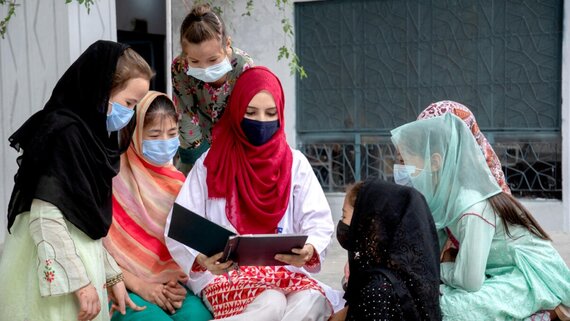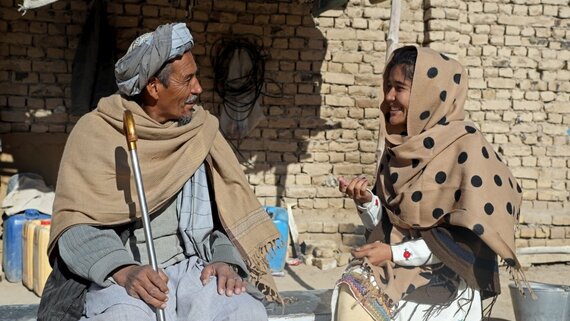Analysis of the context, crisis and needs
Afghanistan’s neighbouring countries, particularly the Islamic Republic of Iran and the Islamic Republic of Pakistan, host more than 2.2 million registered refugees from previous waves of forced displacement, and a further 4 million Afghans of varying statuses. This has stretched the capacity of host communities. The majority of Afghans in both countries reside in urban and peri-urban areas, relying on national public services that are largely available to them. Despite their own challenges and their populations’ needs, Iran and Pakistan have upheld their international protection obligations for decades and pursued inclusive policies, notably in areas of education, health care and human capital development. However, the difficult economic situation in these and other neighbouring countries, exacerbated by the COVID-19 pandemic and a growing asylum fatigue in some host communities, is creating further challenges for the host governments to continue their policy of inclusion of Afghans in national systems.

Attock, Pakistan
Two decades ago, this Afghan refugee, Saleema, was one of only a handful of refugee girls attending classes at the Barakat Primary School in Attock, west of Pakistan’s capital, Islamabad. Now, age 29, Saleema is speaking to a class of about 30 young refugee girls at her old school, wearing a doctor’s coat. “As a child, I was not aware of my refugee status,” she said. “But I came to know about it when my classmates were getting admitted to colleges of higher education, and I was not because I’m a refugee.” Today, Saleema’s story and work are bringing change. Some of the staunchest opponents of girls’ education in her community call her to seek health advice for their wives, sisters and daughters. Many now send their daughters to school in the hope that they might follow in Saleema’s footsteps.
UNHCR/Amsal NaeemThis further highlights the need for programmes aimed at fostering coexistence and alleviating the burden on host communities. In addition, humanitarian programmes to support the existing Afghan populations in the region have been critically underfunded in recent years. In parts of Central Asia, COVID-19 has already triggered unprecedented health, humanitarian and socioeconomic crises, and a refugee influx may further stretch the already overwhelmed government capacities and exacerbate vulnerabilities.
At the same time, the humanitarian situation in the Islamic Republic of Afghanistan deteriorated dramatically in 2021, with significant consequences for the most vulnerable among the population. This year, over 677,000 people (80 per cent women and children) have been internally displaced by conflict, adding to some 2.9 million previously displaced by conflict. One in three Afghans is already food insecure, and 97 per cent of the population could plunge into poverty by 2022. The further deterioration of the socioeconomic situation will likely trigger additional internal and cross-border displacement.
Projected situation in 2022 and beyond
With the situation inside Afghanistan showing no signs of improvement, and Afghans and host communities in neighbouring countries facing increased challenges, greater burden and responsibility sharing is required from the international community. As such, within the framework of the 2022 RRP, over 40 partners will focus on a response to refugees and host communities in neighbouring countries, including registered Afghan refugees and asylum-seekers and Afghans of varying statuses, including undocumented people, host communities and potential new arrivals. The RRP builds on the collective work already being done in neighbouring countries and promotes an area- and needs-based approach. Area-based investments are needed in health, education, clean and renewable energy, vocational skills development and social protection to mitigate the impact on national systems and support the inclusive policies of the host governments, benefiting both host communities and refugees. These investments will also build Afghans’ human capacity and resilience and eventually enable sustainable return and reintegration when conditions are conducive. In line with the Global Compact on Refugees (GCR), the Solutions Strategy for Afghan Refugees (SSAR), the SSAR Support Platform launched at the Global Refugee Forum in 2019, and the implementation of the SDGs, the 2022 RRP will support host governments in their efforts to promote resilience. It will aim to ensure that no one is left behind and that the needs of Afghans and their host communities can be met.

Quetta, Pakistan
This 22-year-old girl is an Afghan refugee in Pakistan. She often struggled to continue her education while also helping to provide for her family, but she has now set up an informal school at her family home for around 50 Afghan children. She explains: "Where I live, many children are deprived of education due to poverty. I saw for myself that some families were reluctant to allow their sons to attend my school, as these little boys were bringing in a bit of money each day by working odd jobs. It was even harder to convince some parents to enrol their daughters in school, given the traditional roles associated with women and girls. There has since been some improvement, but the process of change is always slow. But even with a good education, the life of a refugee is very tough. Our degrees do not necessarily help us to get jobs, and we don’t live with the same sense of freedom that others have. Sometimes taunts and other acts of discrimination make us feel isolated and alienated from the society where we live, and which we were born into."
UNHCR/Humera KarimIn 2022, the situation inside Afghanistan is likely to remain fluid. According to UNDP’s rapid appraisal on Economic instability and uncertainty in Afghanistan after August 15, the country may face universal poverty by mid-2022 and could be on its way to a developmental collapse. An estimated 72 per cent of Afghans are already living below the poverty line, but this percentage is at risk of rising to 97 per cent of the population unless the country’s political and economic crises are urgently addressed. Given this background, borders are likely to remain tightly regulated and movement may take place irregularly, increasing the vulnerability, including to exploitation, of people crossing borders, both during their journey and upon arrival as well as deportation. In neighbouring countries, the difficult situation described above necessitates a scaled-up response from the international community to ensure that the immediate needs of Afghans and their host communities are met, to promote resilience, facilitate solutions and stabilize displaced populations. In accordance with the principle of AAP, communities will be actively engaged in planning, implementing and evaluating the response by soliciting, hearing and acting upon the voices and priorities of women, girls, boys and men, including the most marginalized and at-risk people among affected communities. In addition, measures to prevent, mitigate the risks of and respond to sexual exploitation and abuse will be prioritized and integrated in all sector programmes.
Response priorities in 2022
Reaffirming the regional multi-stakeholder and multisectoral approach that bridges humanitarian and development assistance and builds community resilience, the RRP will deliver concrete actions, with a focus on community-based interventions incorporating an AGD approach, cross-border collaboration, and durable solutions in line with the SSAR and the SSAR Support Platform. The 2022 RRP will aim to:
- Ensure coordinated efforts and support towards durable solutions by enhancing conditions and community-based investments. The response will support the resilience of refugees and host communities, including through investments in key areas of national infrastructure, such as education and health, and by supporting livelihoods for Afghans and host communities, in keeping with the SSAR.
- Support host governments to ensure access to asylum and protection in accordance with international standards, including respect for the principle of non-refoulement, admission, registration and documentation.
- Provide multisectoral humanitarian assistance to targeted populations, anchoring the response in government systems wherever possible in line with the GCR, paying particular attention to the needs of children, youth, women, the elderly, persons with disabilities and other people with specific needs.
- Reinforce government efforts to ensure that emergency preparedness and response measures are put in place to respond to potential new arrivals.
Further reading
Source: UNHCR
References
- UNHCR - The Global Compact on Refugees
- SSAR Support Platform
- UNDP Press release - "97 percent of Afghans could plunge into poverty by mid 2022, says UNDP", September 9, 2021.



